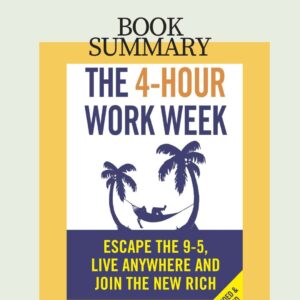4 hour work week summary
In today’s fast-paced digital age, the concept of achieving more in less time holds significant appeal. One book that has captured the imagination of many seeking to escape the traditional 9-5 grind and create a lifestyle of freedom and flexibility is the 4-Hour Work Week by Tim Ferriss. Ferriss, a renowned author, entrepreneur, and productivity guru, introduces readers to innovative concepts and strategies that challenge conventional wisdom in the realm of work and lifestyle design.
BOOK SUMMARY

Table of Contents
1. Ferriss’ Principles of Lifestyle Design: Definition and Explanation
- Pareto’s Principle (80-20 Rule): Ferriss highlights the significance of focusing on the 20% of activities that yield 80% of results, emphasizing the importance of efficiency over mere busyness.
- Parkinson’s Law: This concept states that work expands to fill the time allotted for its completion, urging individuals to set strict deadlines to boost productivity.
- Difference between Effectiveness and Efficiency: Ferriss distinguishes between being effective (doing the right things) and being efficient (doing things right), encouraging readers to prioritize activities that align with their goals.
2. Explanation of DEAL System
- Definition: The DEAL system comprises Elimination, Automation, and Liberation, which form the core pillars of transitioning to a streamlined work week.
- Elimination: Involves identifying and removing non-critical tasks to streamline workflow and focus on high-impact activities.
- Automation: Utilizing technology and tools to automate repetitive tasks, thereby freeing up time and mental energy for more important endeavors.
- Liberation: Embracing the mindset shift required to detach work from a physical location, enabling remote work and flexibility.
3. Importance of Thinking Differently
- Shifting from the traditional 9-5 work routine to a 4-hour work week may seem radical, but Ferriss emphasizes the importance of challenging societal norms and exploring alternative approaches to achieve greater autonomy and fulfillment.
IMPLEMENTATION OF THE 4-HOUR WORK WEEK
1. Effective Time Management Techniques
- Prioritizing tasks using methods like the Eisenhower Matrix to ensure focus on important, not just urgent, activities.
- Utilizing time blocking strategies to allocate specific time slots for various tasks, enhancing productivity and reducing distractions.
2. Outsourcing and Automating Tasks: How and Where to do it
- Leveraging freelance platforms and virtual assistants to delegate non-core responsibilities and scale productivity.
- Implementing software tools for task automation, such as project management apps and email scheduling tools.
3. Balancing Work & Personal Life
- Recognizing the significance of work-life balance in preventing burnout and maintaining overall well-being.
- Embracing mobility and the freedom to work from anywhere to enhance lifestyle flexibility.
By adopting the principles outlined in the 4-Hour Work Week, individuals can unlock new possibilities for designing a lifestyle that prioritizes personal fulfillment and efficiency over conventional notions of work. Stay tuned for the second part of this article, where we delve deeper into criticisms, case studies, and a comprehensive conclusion.
Criticisms and Controversies
The 4-Hour Work Week by Tim Ferriss has garnered both praise and backlash since its inception. In this section, we delve into the criticisms and controversies surrounding this revolutionary approach to work and lifestyle design.
1. Criticisms of the 4-Hour Work Week
- Misconception of Laziness: Critics often label the concept of the 4-Hour Work Week as promoting laziness or seeking shortcuts to success. However, the core principles of the book focus on efficiency and effectiveness rather than idleness.
- Unrealistic Expectations: Some argue that Ferriss’ methods may not be feasible for everyone, especially those in traditional employment arrangements. The idea of working only four hours per week may seem unattainable to many.
- Lack of Work-Life Balance: Opponents claim that striving for extreme productivity may lead to burnout and neglect of personal relationships. The emphasis on work efficiency could potentially overshadow the importance of well-being and leisure time.
2. Addressing the Controversies and Misunderstandings
- Balanced Perspective: While the title may suggest minimal work hours, Ferriss actually advocates for maximizing output in minimal time through smart strategies and automation. It’s about working smarter, not necessarily less.
- Adaptability: The 4-Hour Work Week principles can be customized to suit individual circumstances. Not everyone may achieve a literal four-hour work week, but the concepts can be applied to enhance productivity and create more freedom in one’s life.
- Realistic Expectations: Understanding that the book serves as a blueprint for lifestyle design rather than a strict formula is crucial. Each person’s journey to a more efficient and fulfilling work-life balance will be unique.
FAQs
What is the main concept behind the book 4-Hour Work Week?
The main concept of the book revolves around achieving more by working less through principles of lifestyle design, effective time management, and leveraging automation and outsourcing.
Who is Tim Ferriss and why is he known for the 4-Hour Work Week?
Tim Ferriss is an author, entrepreneur, and productivity guru known for his book 4-Hour Work Week, which promotes the idea of designing a lifestyle focused on freedom and efficiency.
How can one implement the 4-Hour Work Week principles in real life?
Implementation involves adopting strategies like effective time management techniques, outsourcing tasks, automating processes, and balancing work and personal life to maximize productivity and freedom.
What are some common criticisms of the 4-Hour Work Week?
Critics often argue that the concept of working only four hours a week is unrealistic and may not be applicable to all professions or industries. Some also question the sustainability of passive income models.
Are there success stories of people who have successfully implemented the 4-Hour Work Week principles?
Yes, there are numerous success stories of individuals who have transformed their lives by applying the principles outlined in the book, achieving financial freedom and a better work-life balance.
Conclusion
In conclusion, the 4-Hour Work Week offers a paradigm shift in how we view work, productivity, and life balance in the digital age. By understanding and implementing principles such as lifestyle design, effective time management, and outsourcing, individuals can strive towards achieving greater efficiency, flexibility, and autonomy in their work lives. Embracing the concepts laid out in the book can lead to a more fulfilling and enriching way of living that prioritizes freedom and personal growth. It is through a combination of mindset shifts and practical applications that the 4-Hour Work Week methodology can revolutionize the way we approach work in the modern world.




